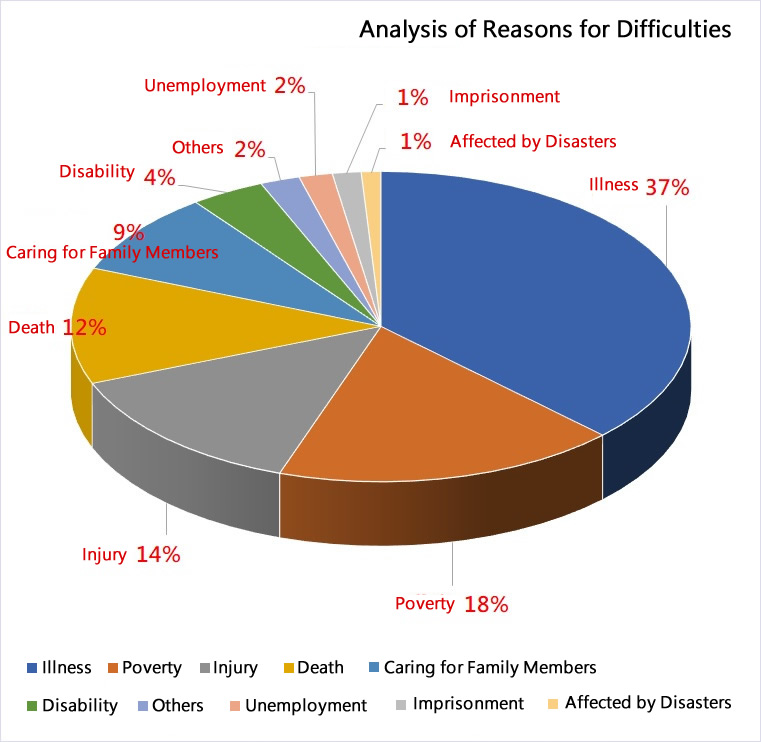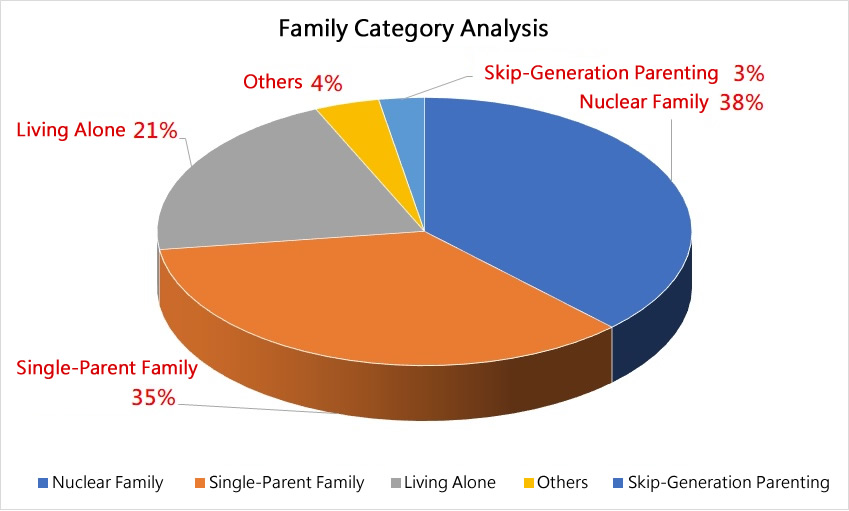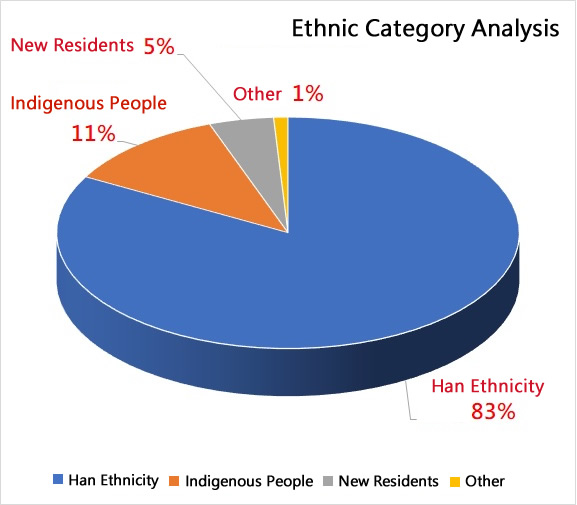Since its establishment in 1996, the Chang Yung-Fa Charitable Foundation has been actively involved in providing social assistance, and has successively invested NT$1.25 billion in social assistance, helping 95,000 families and benefiting 320,000 people. The cumulative amount of disaster relief distributed amounted to NT$2.05 billion, totaling about NT$3.3 billion in charitable aid. The above figures are cumulative until 2021), and remains ongoing.
As the proverb goes, “you cannot make bricks without straw” To provide more efficient social assistance and to accurately invest resources, the Foundation has analyzed tens of thousands of cases from our computer database as follows:
1. Analysis of the occurrence of distress and reasons of cases

(1) Serious illness accounts for 37% of cases
The total income of the families who have received assistance from the Foundation is generally around NT$20,000 to NT$30,000. The vast majority of these families rely on temporary or part-time work, with unstable income and job opportunities. Their income from such work is barely enough to cover their daily expenses, and they are ill-prepared to deal with unexpected emergencies.” As the Taiwanese proverb goes, “sickness comes like a landslide, but goes slowly like spinning silk” (Diseases come on horseback, but go away on foot). When a family member experiences an abrupt illness, especially a severe one that causes paralysis, the resulting medical expenses that exceed the coverage provided by national health insurance can swiftly accumulate. These expenses may include costs for medical procedures, nutrition, medical supplies, or nursing care, leading to a ripple effect that could destabilize the family's financial security. Even when they cannot afford to pay for care, the family breadwinner often has to stop working and personally take care of the sick family member, resulting in a vicious cycle of no income and unaffordable living expenses. Moreover, in some cases, the breadwinner of the family is the one who falls ill. This can lead to a downward spiral of difficulties, as the family's finances rely on borrowing to make ends meet. However, for disadvantaged families, borrowing money is not an easy option.
(2) Poverty accounts for 18% of cases
18% of those seeking assistance are in dire circumstances due to poverty. These families already experience poverty in their daily lives, regardless of whether they have encountered emergency situations or not. Their lives are already a struggle. Most of them are suffering from long-term poverty due to lack of education, physical and mental disabilities, and lack of professional qualifications or capabilities, which often cause families to have poor income or rely on government subsidies to “maintain” their basic lifestyle. They cannot support their basic livelihood, encounter long periods of not being able to make ends meet and living in hardship, and are unable to find a way out of their predicament.
(3) Injury accounts for 14% of cases
14% of the disadvantaged families are in distress because of injuries, usually caused by car accidents, work accidents, general accidents or disasters. Those with minor injuries may experience temporary hardship but can usually recover or return to work within a short period of time. However, in severe cases such as fractures, physical or mental disabilities, or paralysis, long-term rehabilitation is required. While some individuals may eventually recover, others may suffer permanent disabilities and become unable to support themselves. Same as the illness factor, even if the injured person is not the breadwinner, the medical expenses incurred during the recuperation period have already caused an additional burden on the family's finances. If the injured person is the breadwinner, even living expenses will become a problem and financial pressure will follow, causing the disadvantaged family to collapse overnight.
(4) Death accounts for 12% of cases
12% of the families seeking assistance do so because a family member has passed away and they are unable to afford funeral expenses or because the family has fallen into hardship due to the death of a member. Vulnerable families, due to their already weak resources to deal with emergencies, face difficulties in raising funds for funeral expenses once a family member has passed away. In addition, if a family’s breadwinner dies, not only will it problematic in terms of funeral expenses, but also the living expenses of the family will often encounter difficulties as well. Otherwise, the funeral expenses might affect the ability to pay for living expenses, which will cause hardship in life.
(5) Caregiving for family members accounts for 9% of cases
Some families seeking assistance are in trouble because they are unable to work and earn money because they have to take care of their family members. If a sick or elderly family member is unable to take care of himself/herself and needs to be taken care of for a prolonged period of time, and it is a heavy burden to send the family requiring caregiving assistance to an institution or hire a foreign caregiver to take care of the family member at home, it shall pose a heavy financial burden on the family affected. For those who cannot afford it, they might be compelled to provide at-home care to their family member, even having to leave their jobs to take care of family members. Although the government is currently promoting the Long Term Care 2.0 system, the hours of long term care provided can only be considered as an aid to reduce the pressure on the caregiver. Some parents in single-parent families have to take care of their young children aged 0 to 4 on their own, and they cannot afford to pay for childcare or nursery school expenses, so they have to take care of their children at home, and even going out to work becomes unattainable.
(6) Disability accounts for 4% of the population
The social welfare system cannot support the lives of people with physical and mental disabilities, and there are many barriers to finding a job. 4% of the case investigators met many people with physical and mental disabilities who are trying to earn their own living, but they observed that it is really difficult for those who have the ability to work to find a job, and those who do not have the ability to work subsist on government subsidies alone. There is still much room for improvement in the care and opportunities for people with physical and mental disabilities.
(七) Unemployment, disaster, serving a prison sentence and others account for 6% of cases
Disadvantaged families are not able to cope with emergencies, and when they encounter unpredictable factors such as unemployment and disasters, they are often unable to respond and adapt, and their lives are immediately put in a difficult situation. In addition, some family breadwinners are sentenced to prison for illegal conduct. While it is only natural that they pay the price for their actions, the dependents in the family who are incapable of working face immediate hardship.
Conclusions:
Among the above causes of distress, 37% are due to illness and 14% are due to injury, which adds up to 51%; that is, half of the causes of distress in the Foundation's cases are strongly linked to medical problems. This observation highlights the importance of the safety and health of family members in vulnerable families with weak economic resources, because if one of the factors is jeopardized, the family is immediately in trouble. Compared to ordinary families, disadvantaged families usually do not have the resources and time to pursue a healthy lifestyle; meals cannot focus on nutrition, the family is in dire financial straits, and to be able to put food on the table becomes a luxury. And most of them are engaged in laborious work, have long working hours, inadequate rest at home. Few can afford time to maintain exercise, so the vicious cycle of health deterioration means they are prone to getting sick or injured, exacerbating the family’s situation.
2. Analysis of the types of families in distress

(1) Nuclear families make up 38% of cases
According to its definition, a nuclear family is a form of family combination, referring to the marriage-based family, with only the husband and wife and unmarried children living together. The burden of a member family is slightly less, but the members of a nuclear family also lack family support and companionship. According to government statistics, 34.44% of Taiwan's family formations are nuclear families. The largest proportion of the Foundation's families seeking assistance are nuclear families. According to the interviewers' experience, Taiwan is today dominated by industrial and service industries, and job opportunities have concentrated in metropolitan areas and satellite cities, resulting in population movement, making nuclear families the mainstream of family formation. However, the disadvantage of the nuclear family is that the interaction and affection between family members and friends is getting weaker and weaker, and the family support from the past agricultural society is gone. In the event of an emergency, relatives and friends can offer little to no assistance.
(2) Single-parent families account for 35% of cases
Government statistics show that single-parent families account for 10.21% of Taiwan's family composition, while the percentage of single-parent families seeking help from the Foundation is as high as 35%, indicating that single-parent families do have fewer resources and are generally less able to cope with emergencies. Many single-parent families are economically marginalized, and poverty makes it impossible for their children to enjoy a normal standard of living and education when they grow up. Moreover, because single parents have to bear the double responsibility of financial burden and parenting, under long-term financial and mental pressure, they are susceptible to depression and mental problems. Single-parent families are prone to problems in work, residence, childcare and parenting, physical and mental development of children, and parent-child relationship. In case of emergencies, they are often unable to cope with them.
(3) Solitary individuals account for 21% of cases
According to government statistics, 12.26% of Taiwan's families are those living alone, and according to the Ministry of the Interior, there is a growing trend of one-person households. According to the Ministry of Interior, the percentage of one-person households continues to grow. 21% of households seeking help from the Foundation are one-person households. If elderly individuals are financially independent and capable of taking care of themselves, living alone in their homes while their children work may not pose a significant issue. However, when these individuals are advanced in age, seriously ill, or physically or mentally incapacitated, their financial resources are limited and the support provided by their children or relatives is restricted, making it more probable that they will be unable to manage daily life or cope with unexpected situations. The interviewers observed that there are two types of one-person households. The first type is unmarried young people who work and live alone in urban areas and earn only enough to support themselves. As a result, they become estranged from their families and friends over time, and when they encounter problems such as unemployment and injuries, hardship ensues. The second type occurs more often in agricultural counties, where the young adults migrate to start a family, leaving the elderly alone in their hometowns, and the migrating family members are not financially capable and cannot support the elders in their hometowns, resulting in the elderly being left alone.
(4) Intergenerational parenting and others account for 7% of cases
In intergenerational families, grandchildren live with their grandparents and take care of them. The interviewers observed three types of phenomena. First, the parents are irresponsible and leave their minor children to the elders, leaving both financial and parenting responsibilities to the grandparents. The grandparents are basically incapable of providing parenting care and are of advanced age, so they can only work part-time to earn enough money to support their grandchildren. In the second type, the grandparents are able to provide for the grandparents' living expenses, but the grandparents are unable to raise the grandchildren, which results in the grandchildren growing up without being taught properly, and thus sowing the seeds of future misbehavior. In the third type, the grandchildren have grown up and are taking care of their elderly grandparents .If the grandparents are frail and need to be taken care of, the grandchildren are unable to work in order to take care of their grandparents, and the grandchildren's livelihood is suddenly in trouble.
3. Analysis of the types of groups that have difficulties

(1) 83% of Han Chinese ethnicity, 11% of indigenous people, and 5% of new immigrants.
(2) The percentage of indigenous families in Taiwan is about 2.27%, while indigenous families account for 11% of the total number of cases of the Foundation, indicating that the Foundation has invested a lot of resources in disadvantaged indigenous families. Indigenous families generally engage in manual labor, often in temporary jobs, and opportunities for work in their hometowns are limited. As a result, their income is generally unstable, leading to a weak economic foundation for many indigenous families. Some families experience emergencies or chronic poverty, which can lead to financial problems. Due to their economic vulnerability, indigenous families often lack resources for healthcare and children's education, among other things, which can further exacerbate their relative disadvantage in society. New immigrants make up 5% of the Foundation’s cases. New immigrants who have left their home countries and come to Taiwan from afar immediately face problems in adapting to life, including marriage and relationship adjustment, relationship with in-laws, language communication difficulties, nationality discrimination, cultural adaptation, economic instability, and parenting education. In new immigrant families, the majority of domestic spouses are from socially disadvantaged groups, and most of the families they form are economically disadvantaged; most of the new immigrants work as temporary or engage in basic work, and their children have limited educational resources. In case of divorce, in which case the new immigrant becomes a single parent, the family is put into more dire straits.

